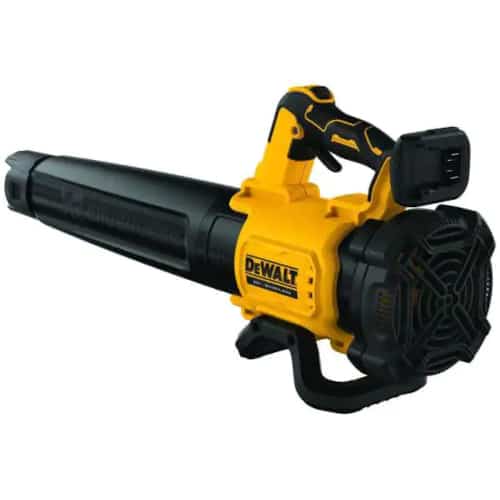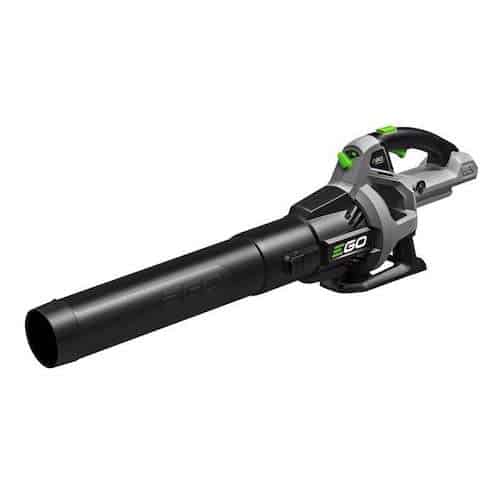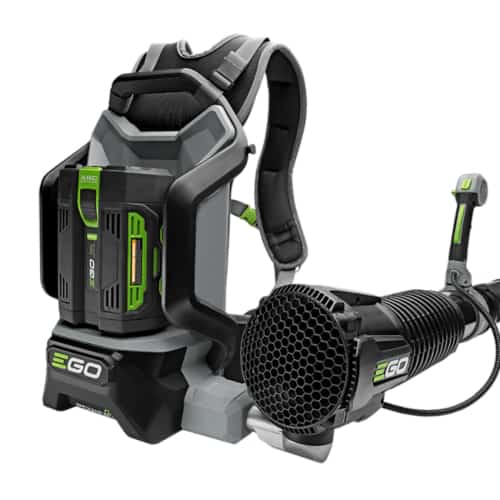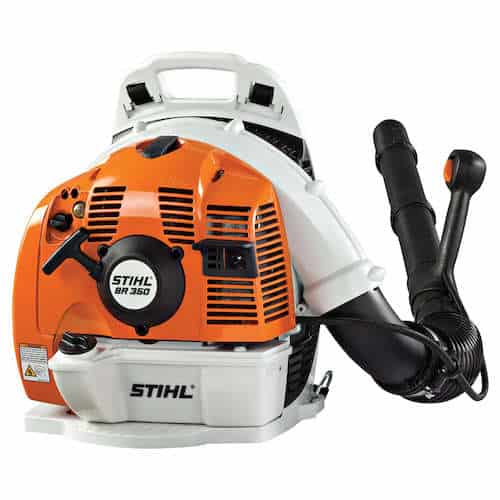Table of Contents
Most of us are familiar with the soundtrack of summer: yard maintenance tools.
Lawnmowers, weed whackers, and leaf blowers abound. (Not necessarily in that order.) But did you know leaf blowers are great for all kinds of tasks in all seasons? True story.
So whether you’re looking ahead to fall foliage, summer flurries, or the spring cleaning that plagues us all, a leaf blower’s one of the most useful garden-tools-that-aren’t-just-garden-tools ever.
Why Buy a Leaf Blower?
Oh man, the reasons are many, but laziness and efficiency may be at the top of the list. Listen, we’re just keepin’ it real here—a broom or manual rake is great, and it’s good exercise and all, but sometimes you just want to get the yard DONE. After all, fast cleanup is the best cleanup.
Also, a leaf blower is a lot better at removing slippery leaves and debris, and it’s a good option for cleaning up all kinds of areas, from the yard to decks to patios to sidewalks and more. Not only that, but you can use it to tidy your space all year round.
At the risk of sounding like an infomercial, leaf blowers are multi-taskers, too! Got an intimidating snow mountain of snow on your car? Blow it off. Got clogged gutters? Same. You can get rid of grass clippings off the sidewalk and curb or even reverse it and vacuum up confetti after a crazy piñata party. Nice.
Buying Considerations
Okay, so leaf blowers are gardening tools that propel air out of a nozzle to move or collect yard debris. They can run on electricity, a battery, or gasoline.
Helpful? Probably not so much. There’s a wide array of leaf blowers out there with plenty of different features, so choosing one can be a bit daunting without a bit of education about what to look for. Here’s what you should know:
Leaf Blower Power Varieties
There Are Battery-Powered Leaf Blowers
Battery-powered blowers run on, you guessed it, battery power. Overall, they’re less powerful than corded blowers or those that run on gas, but the upside is that they’re usually portable and lightweight (often weighing in between 0.5-5 pounds).
They’re more affordable, too, with prices generally ranging between $35 to $150, and come in cordless or hybrid corded styles.
The pros? They’re cheaper, more lightweight, less noisy, more portable, and most importantly, they’re much more eco-friendly than gas-powered blowers.
Cons? They don’t have the power that most gas or corded blowers do. Also, the battery can sometimes get dicey and run out or overheat.
Gas-Powered Leaf Blowers
First thing you should know: You can’t just take your gas-powered leaf blower to the gas station for a fill-up; some require a specific ratio of gas/oil, so be sure to consult your user’s manual for the manufacturer’s recommendation for which mixture to use.
Okay, now that that’s out of the way.
They’re more potent than battery-powered blowers and corded electric blowers with the same engine size. They can weigh anywhere between 8 and 10 pounds (without gas in the tank).
They vary wildly in price, with the cheapest gas-powered blowers running around $75. The more expensive varieties can set you back upwards of $2500. Throw in the gas price, and you’ve got a pretty pricey blower.
So what are the pros? Well, for a start, you don’t have to wait for a gas-powered blower to recharge. They’re versatile, convenient, and usually offer significantly more power than other blowers.
The cons? Gas-powered blowers are usually pretty loud and can get stinky with the fuel exhaust fumes and whatnot. In fact, some places don’t allow the use of gas-powered leaf blowers, so check out your homeowner’s association bylaws (where applicable) to make sure you’re good to go before buying one.
Good to know:
There are two kinds of gas blowers- two-cycle and four-cycle. Essentially, the difference lies in how the engine is lubricated. Two-cycle engines are easier to maintain and simply require a mixture of gas and oil in the tank to run. In a four-cycle blower, the gas and oil are kept in separate receptacles within the blower. As a rule, a two-cycle engine is more powerful, but a four-cycle is more efficient in fuel consumption.
And Finally, Electricity-Powered, Corded Leaf Blowers
These guys plug into the wall, and even though they usually come with extra-long cords, you’ll probably want to have an extension cord handy for some jobs.
Generally, they run from $60 up to $500, and as far as power output goes, they are kind of the goldilocks of leaf blowers, with wind speeds falling smack in between battery and gas blowers. (150 MPH or so.) They usually weigh around 8 lbs, but some are lighter than that.
The pros: If you don’t need a ton of power but have a sizable area to clear, an electric blower is a great option. (Provided you’ve got a long enough cord to reach.) They’re suitable for extended use, too, as they won’t need to recharge or refill and are low maintenance comparably.
The cons: They’re corded, of course, so your space may be limited to how far your cord will stretch. They also may not take care of some larger jobs because they’re not as powerful as a gas blower.
Leaf Blowers Come in a Few Different Styles:
Backpack Leaf Blower
There’s a reason the backpack leaf blower is often the pro landscaper’s choice! Backpack leaf blowers can be either gas or battery-operated and are ideal for portability. They’re easy to use, make faster work of jobs like gutter cleaning, and have all the power to boot due to their larger engine. On the other hand, it’s substantially heavier than the average handheld blower because of its engine size.
Cordless
Cordless leaf blowers are nice and lightweight, but since they’re battery-powered, they’re not as powerful as their corded and gas-powered cousins. They require recharging time, but you can always get an extra battery to extend your usage time.
Handheld
A handheld blower is just that- a blower you hold in your hand to use. The majority of leaf blowers fall under this category, and they can be corded, cordless, or gas-powered. A handheld blower can be a little more awkward and heavy enough to inflict some arm fatigue. On the bright side, if you switch hands as you use it, you can skip arm day at the gym.
Walk-Behind
This is the guy the pros call in for the biggest jobs! It’s meant to be pushed like a lawnmower and features a big ol’ fan on the front to do the blowing part. And like a lawnmower, they come in push-powered and self-propelling styles.
There are four grades of walk-behind blowers ranging from entry to the commercial level. Surprisingly, many entry-level walk-behind mowers only have as much power as an average handheld. But if you tire easily and need a little help, a self-propelled mower is much easier to use for extended periods.
Some Leaf Blowers Come With Handy Features:
Leaf Vacuum Capabilities
Want to turn your blower into a yard vacuum? Why not, right? Some blower models come with the ability to blow away yard debris and vacuum it up. All you have to do is vacuum your lawn, detach the debris bag, and dispose of your yard debris as you see fit. (Composting is a good option!)
Note: If you have a larger yard or a lot of trees that drop more leaves than you can keep up with, you may want to consider purchasing a yard vacuum separately because blower/vacuum combos don’t have as much sucking power.
Integrated Mulchers
If you’re on board with the idea of a blower/vacuum combo, a blower that takes it a step further and mulches your yard debris may be even better! This handy feature sucks up the leaves, shreds them, and then spits them out into the debris bag to be composted. Or whatever you want to do with it.
Speed Controls
Not every blower offers a variable speed control function, but it’s a handy little feature. It gives you the option to harness more speed for jobs with muddy or wet debris, but dial it down if you need to blow lighter leaves or lawn clippings. Some models even feature a locking speed control mechanism to lock onto your desired speed without having to keep a hand on the speed control while in use.
Vibration-Dampening
As you might imagine, leaf blowers can drum up some pretty hefty vibration due to the motor and airflow, causing some bodily fatigue for you when in use for extended periods. A vibration-dampening feature makes the job much easier, especially in heavier backpack models.
Hybrid Power Sources
There are plenty of blowers on the market that operate as both battery-powered and corded. This is handy when you need the flexibility to roam further away than your cord will reach or need to use the blower while the battery charges.
Attachments
Most leaf blowers can accommodate a variety of nozzles, hoses, and leaf collection systems to help you tackle different jobs with different requirements. Kind of like a vacuum cleaner.
Directional Controls (for walk-behind blowers)
While some walk-behind blowers only blow straight ahead, some include a directional control function so you can aim the airflow where you’d like to blow your debris. This feature is convenient when you’d like to blow debris against a wall or boundary or all your leaves into a big mound in the middle of the yard to jump into when you’re done.
The Best Leaf Blowers For Your Outdoor Space
1. Dewalt Brushless Handheld Leaf Blower
by Dewalt

Specs:
- 450 CFM/125 MPH
- 20 volt
- 5.3 lbs
- 66-decibel noise rating
- Battery-powered
- Handheld design
- Three-year limited warranty, one-year free service, 90-day money-back guarantee.
Pros:
- Indoor/Outdoor compatible (useful if you’ve got a messy garage or basement floor)
- It’s quiet enough to use in noise-restrictive areas
- Features a variable trigger and speed lock for better power control
Cons:
- The battery and charger aren’t included in this package.
- Some users had difficulty registering for the warranty on time, and Dewalt was somewhat inflexible about honoring it.
With a maximum CFM of 450 and MPH of 125 MPH, this blower delivers some decent power while staying lightweight enough to use comfortably (even with the lithium-ion battery). An excellent choice for basic and smaller jobs.
2. Ego Power+ LB5300 Handheld Blower
by Ego Power

Specs:
- Maximum 600CFM/200 MPH
- 5 lbs
- 65-decibel noise rating
- Battery-powered
- Handheld design
- Five-year limited warranty
Pros:
- Features interchangeable nozzle connections
- Has a variable speed dial for customized control
- Lightweight and easy to use.
- Weather-resistant
Cons:
- This is a tool-only package without the charger or battery.
- Some users reported that the battery became easily disengaged.
This blower got resounding applause from homeowners looking for a lightweight, low-maintenance blower that’ll easily tackle smaller spaces. (The next-gen model got great reviews on Consumer Reports, too.)
3. Ego Power Backpack Blower
by Ego Power

Specs:
- Maximum 600 CFM/145 MPH
- 12.5 lbs
- Battery-powered
- Backpack design
- Five-year limited warranty
Pros:
- Weather-resistant
- The tube length is adjustable
- The harness and waist belt is adjustable for comfort
- Variable speed control
Cons:
- Louder than other battery-powered blowers
- Its higher airspeeds often mean shorter battery life, but to be fair, that’s true for every variable speed enabled blower.
This backpack blower scored brownie points with users for its power and comfort when wearing it. It’s pretty attractive, too. I mean, it looks like a cool Star Trek jet pack. (Not an indicator of performance, but it counts for something in my book.)
4. Cordless Leaf Blower with Battery and Charger
by Tingmengte
Specs:
- 320 CFM/150 MPH
- 5 lbs
- Battery-powered
- Handheld design
- 24 month limited warranty
Pros:
- Battery and charger included
- Features three extension tubes
- Variable speed control
Cons:
- The battery life will only give you about 20 minutes of continual use at the highest setting. But if you don’t need it for big jobs, that may be a non-issue.
- Some users reported that its construction is a little too flimsy for their liking. Which is a nice way of saying it seems cheap. But again, if you need the minimum, that may not matter to you.
Okay, so this one’s an off-brand, which may be cause for pause if you’re picky with your tools. BUT, we got plenty of positive feedback from customers, and it’s a great value if you want a basic blower.
5. Greenworks Cordless Leaf Blower
by Greenworks
Specs:
- 320 CFM/150 MPH
- 3.27 lbs
- Battery-powered
- Handheld design
- Four-year limited warranty, two-year for the battery
Pros:
- Battery included
- At 53dBs, it’s super quiet
- Extension tube included
- Variable speed control
Cons:
- Some users reported the battery can overheat if left charging too long
- Not suitable for larger jobs
This is the quietest, lightest-weight battery blower on our list. One might even say it’s adorable. The best part? It’s only 60 bucks for the package without the battery and charger and $129 for the 2.0Ah package.
6. Stihl BR 200 Backpack Gas Leaf Blower
by Ace Hardware

Specs:
- 400 CFM/150 MPH
- 22 lbs
- Gas-powered
- Two-stroke engine
- Backpack design
- Two-year limited warranty
Pros:
- Anti-vibration technology
- Fantastic for larger jobs
- A large fuel tank for more extended use
- Variable speed control
Cons:
- At 74 dB, it’s pretty loud, so if you live on a smaller property, you might anger the neighbors.
- Some users reported it’s kind of difficult to use. But to be fair, that’s true with plenty of gas-powered backpack blowers.
Pro-grade construction and durability with plenty of power and ease of use? Sign us up! This is your blower if you’ve got a larger property, farm, or ranch. Also, this blower was highly ranked in Consumer Reports across the board for reliability, sweeping, and loosening.
7. Poulan Pro Backpack Leaf Blower
by Poulan Pro
Specs:
- 475 CFM/200 MPH
- 22 lbs
- Gas-powered
- Two-stroke engine
- Backpack design
- Two-year limited warranty
Pros:
- Load-reducing, adjustable straps
- Heavy-duty performance at a good value
- Variable speed control
Cons:
- At a whopping 96.7 dBs, you’ll want to wear ear protection for sure. And don’t use it if you live in a neighborhood; you’ll get in trouble.
- If your gas tank leaks or you have another problem with it, you can’t order a replacement from Poulan.
This backpack blower works well on a larger property and has plenty of power for big jobs. It’s maneuverable, easy to use, and features a really sturdy frame. Overall, it’s a good value if you need to get a lot of yard work done.
8. Toro UltraPlus Leaf Blower Vacuum and Mulcher
by Toro
Specs:
- 410 CFM/250 MPH
- 8.9 lbs
- Corded electric
- Handheld design
- Two-year full warranty
Pros:
- Yaay, blower/vacuum/mulching capability!
- Comes with a vacuum tube, bottom-mounted leaf collecting zip bag, and a cord storage hook
- The 68 dB noise rating is pretty good for a heavy-duty multi-use tool like this
- Variable speed control in both blower and vacuum mode
Cons:
- It’s kind of awkward to maneuver with the debris bag attached.
- You’ll likely need to buy an extra extension cord because the cord included with this one isn’t designed for long-distance use.
The blower/vacuum/mulcher triple threat is ideal if you’re anything like me and don’t want to buy a separate vacuum, mulcher, and blower. I don’t know if that makes me cheap or efficient, but either way, it’s a really useful feature. And it’s a fantastic value. Really. Like less expensive than some blowers that have less power and features.
Commonly Asked Questions About Leaf Blowers
That depends upon which kind you’re shopping for, and more and more powerful leaf blowers emerge every year, it seems. But generally speaking, a backpack or walk-behind blower will be the most powerful options. The most powerful leaf blowers can even produce 1110 CFMs with 220 MPH wind speeds. That’s a lot of blow-power.
An electric leaf blower is corded. A cordless leaf blower will always be cordless unless it’s a corded/battery hybrid. (But then, strictly speaking, it’s not really cordless, is it?)
Battery life may fluctuate depending on how you use it and the cordless blower you buy. On average, a cordless blower battery will hold 15-30 minutes worth of charge.
If you’re thinking of battery life longevity, a lithium-ion battery (recommended) will last you about five years before you need to replace it.
MPH measures air movement speed, and CFM measures air volume movement. They work together, so it’s important to consider both. But unless you have adequate CFM (or push power), a higher airspeed won’t help so much. The point is, the two should be in proportion.
For reference, a CFM between 450-500 and MPH of 150-190 is a good combo if you’re shopping for an everyday leaf blower.
We answered this one earlier in this post (see “gas blowers”), but it bears repeating because it’s such a frequently asked question. The difference lies in how the engine is lubricated:
Two-cycle engines require a mixture of gas and oil in the tank to run.
Four-cycle engines feature separate tanks for gas and oil.
As a rule, a two-cycle engine is more powerful and low-maintenance, but a four-cycle is more efficient in fuel consumption.
Extension cords suitable for leaf blowers can range between 10 and 16 AWG. (Look for AWG on the jacket to ensure it’s suitable for outdoor use.) The longer the distance you’ll be using it from the outlet, the higher the gauge should be because higher numbers indicate higher amperage and wattage levels.
For reference, a 16 gauge cord shouldn’t be used for jobs beyond 50 feet from your plug; a 14 gauge is suitable for 75-100, and 12 is good for beyond that. Remember that these numbers apply to leaf blowers and not necessarily other outdoor appliances.
As we mentioned above, it depends upon the kind of blower you use. Gas-powered backpack blowers are the heaviest and can weigh as much as 25 pounds with a tank full of gas. The lightest leaf blowers are handheld, battery-powered, and weigh less than four pounds.
Gas = Heaviest (average between 8 and 15 pounds without gas in the tank)
Corded = Goldilocks (average between 5 to 8 pounds)
Battery = Lightest (average between .5 to five pounds)
The choke is the mechanism on a gas-powered leaf blower that draws fuel into the carburetor, which then distributes the proper mix of fuel and air to the engine. (The same as a car’s carburetor.)
It’s called a choke because it “chokes” off the fuel supply to the engine when it’s on and opens up the passage when you turn it off. When starting your gas blower, turn on the choke and pull the starter cord once, then slowly adjust it halfway between on and off before pulling the starter cord a couple of more times to get it up and running. Then you can turn the choke off and get moving.
Some blowers (mine included) need a few minutes to warm up before you can turn off the choke completely.
FYI: If you have the choke on when you start up your blower, and the engine dies when you turn it off, you probably have a malfunctioning carburetor. And that’s a bummer.
Now get out there and do some landscaping!
Are you ready for summertime yard work?! Yeah, me neither. It’s hot, it’s sticky, and it’s a little too much like exercise.
That’s where a handy leaf blower saves the day. Find something lightweight, powerful enough for your needs, and easy to maneuver, and yard work won’t seem too much like work after all.
It also makes quick work of the whole thing, which is essential when you’ve got a date with a margarita at the end of the day.
Here’s to low-maintenance summers.
Did you find this post useful? Then save THIS PIN to your Home Technology board for later!







More Stories
Destination Weddings: Your Ultimate Guide to Saying I Do Away
Elopement Videography: Locations, Costs, and Why Couples Elope
TaylorMade Spider GT Rollback, Notchback and Splitback putters